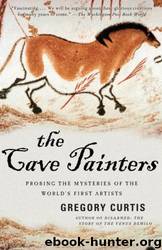The Cave Painters: Probing the Mysteries of the World's First Artists by Gregory Curtis

Author:Gregory Curtis [Curtis, Gregory]
Language: eng
Format: epub
Tags: Arts & Photography, History & Criticism, Criticism, History, Art, Art History
ISBN: 9780307482709
Amazon: B001NJMBDQ
Publisher: Anchor
Published: 2008-12-09T23:00:00+00:00
CHAPTER 7
The Trident-Shaped Cave;
Pairing, Not Coupling
A nnette Laming-Emperaire's thesis adviser, the person who loomed behind La signification from start to finish, was a man named Andre Leroi-Gourhan, who was only six years older than she was. He was indisputably a genius and his work made him as great a figure in prehistory as Breuil, who hated him. Leroi-Gourhan dominated archaeology and anthropology in postwar France in the same way that Jean-Paul Sartre dominated philosophy.
But because Laming-Emperaire was his student, and because the theories that Leroi-Gourhan developed in his voluminous publications are similar—some would say identical—to hers, there has always been an undercurrent of dark academic gossip that Leroi-Gourhan had swooped down upon his student's ideas and claimed them as his own.
This is the kind of seething, divisive feud that French academics find irresistible. The accusations have been repeated so often that Leroi-Gourhan's supposed theft has lately come to be considered an incontrovertible truth in certain circles. But to learn what really happened, it is necessary only to look at what the two people involved, Leroi-Gourhan and Laming-Emperaire, said at the time. The decisive moment for Leroi-Gourhan occurred in 1957 when he entered a cave named Le Portel in the foothills of the Pyrenees just northwest of Foix. For ten years he had been thinking about writing a book on prehistoric art. He had visited various caves from time to time, but now, “having assimilated the available literature”—as he calmly described what would be years of work for most people—he had begun to work in earnest. His original intention was simply to write the text for a book of photographs that would illustrate the history of European prehistoric art, although he did intend for his text to break new ground. He thought that Breuil's work, for all its brilliance, had left a gap. The abbe in describing a cave would often construct a chronology of the works in that one cave, but he had failed to create a systematic synthesis that included all the known art. That's what Leroi-Gourhan originally intended to do.
At Lascaux and Altamira, as well as at other caves he visited, he had expected to see chaos, with works scattered here and there as successive generations of hunters had arrived, made their paintings, and left. He thought he was going to have to work out the dating of the successive waves. Instead he was impressed by the unity within the caves. His interest in dating problems faded quickly, replaced by a fascination with the cave as a whole.
That was his state of mind as he entered Le Portel. This cave is located near a mountain pass. It's shaped like a trident, with the present entry at the end of a long, narrow tunnel that forms the staff. Where the three prongs meet the staff, there is a large chamber where the prehistoric entrance was probably located, although it is now covered with fallen rock. The paintings in Le Portel are well preserved on the whole, but it was their arrangement that struck Leroi-Gourhan with special force.
Download
This site does not store any files on its server. We only index and link to content provided by other sites. Please contact the content providers to delete copyright contents if any and email us, we'll remove relevant links or contents immediately.
The Art of Boudoir Photography: How to Create Stunning Photographs of Women by Christa Meola(18508)
Red Sparrow by Jason Matthews(5374)
Harry Potter 02 & The Chamber Of Secrets (Illustrated) by J.K. Rowling(3614)
In a Sunburned Country by Bill Bryson(3470)
Drawing Cutting Edge Anatomy by Christopher Hart(3441)
Figure Drawing for Artists by Steve Huston(3364)
Harry Potter and the Prisoner of Azkaban (Book 3) by J. K. Rowling(3296)
The Daily Stoic by Holiday Ryan & Hanselman Stephen(3216)
Japanese Design by Patricia J. Graham(3099)
The Roots of Romanticism (Second Edition) by Berlin Isaiah Hardy Henry Gray John(2870)
Make Comics Like the Pros by Greg Pak(2840)
Stacked Decks by The Rotenberg Collection(2797)
Draw-A-Saurus by James Silvani(2636)
Harry Potter and the Deathly Hallows (7) by J.K. Rowling(2631)
Tattoo Art by Doralba Picerno(2586)
On Photography by Susan Sontag(2567)
Churchill by Paul Johnson(2495)
The Daily Stoic by Ryan Holiday & Stephen Hanselman(2445)
Drawing and Painting Birds by Tim Wootton(2424)
